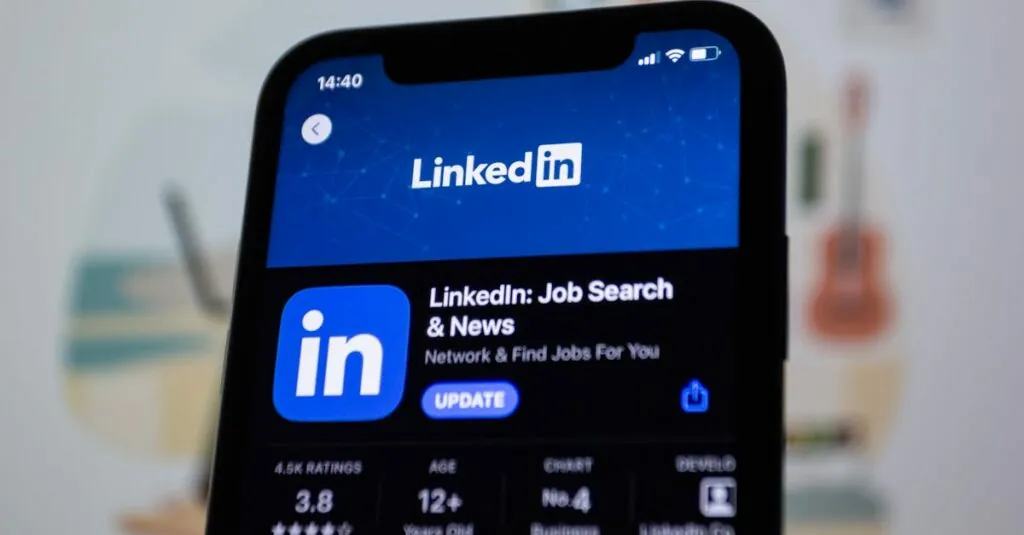Table of Contents
ToggleEver found yourself frantically searching for your iPhone, only to realize it’s playing hide and seek in the couch cushions? You’re not alone. The good news is Apple’s “Find My iPhone” feature is here to save the day, but when does it actually update? Understanding the timing can make the difference between a quick rescue mission and a full-blown treasure hunt.
Understanding Find My iPhone
Find My iPhone provides a crucial service for users who misplace their devices. This feature updates the location of the iPhone at regular intervals, ensuring accurate tracking information. Apple’s service often refreshes every few minutes when connected to Wi-Fi or cellular networks.
Location tracking relies on a combination of GPS data, Wi-Fi signals, and cellular triangulation. GPS signals transmit precise location data, while Wi-Fi helps pinpoint locations in areas with limited cellular coverage. Cellular networks support tracking when other signals are unavailable.
Users can see real-time updates through the Find My app available on other Apple devices. Battery status affects the tracking frequency; if the battery is low, updates may occur less frequently.
Notifications appear if the device enters or leaves predefined locations, offering additional tracking capabilities. Lost Mode allows users to lock the device remotely while displaying a contact number on the screen.
Apple prioritizes user privacy in this process. Location data stays encrypted and accessible only by the device owner. This protection ensures that users feel secure while utilizing the tracking feature.
Understanding these factors can enhance the efficiency of locating a lost iPhone. Keeping the feature enabled maximizes its benefits. Users should ensure location services, Wi-Fi, and cellular data remain active on the device.
How Find My iPhone Works
Find My iPhone operates through a sophisticated system that ensures users can easily locate their devices. This feature relies on multiple technologies for effective tracking.
Location Tracking
Location tracking occurs through GPS data, Wi-Fi signals, and cellular triangulation. Each method contributes to pinpointing the device’s whereabouts. GPS offers precise location information, while Wi-Fi enhances accuracy indoors. Cell towers aid in triangulation, improving location precision in areas with weak GPS signals. Users can access Find My iPhone via the Find My app or iCloud, allowing real-time updates on the device’s location. This versatility makes locating a lost iPhone simpler and more efficient for users in many situations.
Update Frequency
Update frequency is influenced by network connectivity and battery status. When connected to Wi-Fi or cellular data, the app typically updates every few minutes. Low battery levels can lead to less frequent updates, which can slow down tracking. Users relying on this feature benefit from enabling location services, ensuring consistent updates. Notifications also alert users when devices enter or leave specific locations, enhancing tracking capabilities. Understanding how updates work empowers users to optimize their experience with Find My iPhone effectively.
Factors Affecting Updates
Several factors influence how often Find My iPhone updates. Understanding these elements aids in effectively tracking a lost device.
Internet Connection
A stable internet connection plays a crucial role in the frequency of location updates. Find My iPhone relies on either Wi-Fi or cellular data for accurate tracking. When connected to Wi-Fi, updates typically occur every few minutes. Cellular data also enables frequent updates but may experience delays in areas with weak signals. Users should ensure a reliable connection for optimal performance. An intermittent connection can hinder timely updates, making location tracking less efficient.
Device Settings
Device settings significantly impact the functionality of Find My iPhone. Location services must be enabled for the feature to provide accurate updates. Users should also verify that the Find My iPhone setting is activated in the iCloud options. An incorrect setting can restrict location sharing, which impedes tracking capabilities. Battery-saving modes may further limit updates, as these modes prioritize power conservation over app functionality. Adjusting device settings ensures optimal tracking performance when an iPhone goes missing.
Common Scenarios
Understanding the various situations in which Find My iPhone operates enhances its effectiveness.
When iPhone is Offline
When an iPhone is offline, the Find My iPhone feature may provide limited updates. It relies on the last known location broadcasted before losing connectivity. Users can still see the device’s last reported position on a map within the Find My app. Once the device reconnects to Wi-Fi or cellular data, location updates resume automatically. Activation of the “Send Last Location” setting within iCloud allows the device to share its location moments before the battery dies. This feature proves essential for tracking devices when connectivity is an issue.
When iPhone is Lost
In the event that an iPhone is lost, Find My iPhone plays a critical role in recovery efforts. Activation of Lost Mode locks the device, preventing unauthorized access and displaying a contact number on the screen. This mode also uses location tracking to pinpoint the device’s whereabouts. Notifications inform users when their iPhone crosses designated geofences, enhancing tracking options. If someone finds the iPhone, they can view the contact information, allowing for an easy return. Regular updates remain crucial during this time, as they help maintain an accurate location until recovery.
Understanding the update frequency of Find My iPhone is essential for anyone looking to recover a lost device. By ensuring a stable internet connection and enabling location services, users can maximize the effectiveness of this feature. Battery levels and device settings play a significant role in how often updates occur, so it’s wise to keep these factors in check. With the right adjustments, tracking a misplaced iPhone becomes a more efficient and reliable process. Keeping Find My iPhone activated not only enhances recovery chances but also provides peace of mind in an increasingly mobile world.




